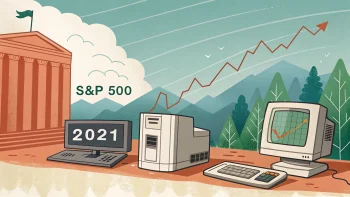If you didn’t take an economics class in high school, you might have lived most of your young life not understanding much about investing and the financial world. Picking between different investment tools and understanding concepts like inflation and recession isn’t always intuitive.
If you’re someone who rolls your eyes at your uncle every time he mentions crypto at Thanksgiving but doesn’t understand crypto yourself, you’re not alone. There’s so much about investing that the average person never learns.
This article will hopefully change that for you. Learning to harness the power of investing while young will help you magnify your assets as an adult.
Key takeaways
- Don’t be discouraged if your financial literacy isn’t very advanced. As a young person, you’re learning to manage your income and budget your expenses, which take time to master.
- The exciting thing about investing as a young person is that you have a longer time horizon, so you can comfortably take on more investment risk.
- Use the tools made available to you. For example, if your bank offers automatic monthly contributions to an investment account, it can save you time and make you a more consistent investor.
Table of Contents
ToggleWhy Should I Care About Investing?
Say you’re a young person living in March 2023. You’re living in a world still emerging from a global pandemic, a multi-year disruption to everyday activity that caused a short recession and widespread economic hardship.
Economists are talking about an impending recession, and you’ve heard from friends and family in the tech industry about mass layoffs and workplaces shifting to incorporate artificial intelligence products. Massive changes like these will continue to happen every year for the rest of your life, inevitably affecting you and your finances.
Inflation and recession are natural parts of the economic cycle. As you age, learning to adapt and take advantage of them will become an increasingly valuable skill.
Investing Should be a Habit, Not an Event
Investing at its most basic involves putting money into an asset you hope will appreciate and generate income over time.
You should invest regularly and for the duration of your career. Think of it like a regular line item in your monthly expenses. But unlike your rent or streaming service bill, investing is a way of paying future you.
It’s Not your Grandparents’ Stock Picking Era
The digital age has transformed many things, including how the average investor accesses and monitors the stock markets. While our grandparents watched the stocks via news headlines and calculated guesses with a stock broker, we now have access to various down-the-minute digital tools to help us understand the market and make intelligent investments directly through online platforms.
An excellent first step in improving your investing habits is understanding what digital investing tools are available.
Simple Tools That Can Help You
Automatic Contributions
To invest regularly, you can often set up an automatic contribution through your bank, so money moves from your checking account to an investment account monthly on a date of your choice.
In the same way setting up automatic payments for a credit card statement can save you time and protect you from fees or penalties if you forget, automatic investing contributions can make you a more consistent investor and make life easier.
Reinvesting Dividends
When stocks do well, they pay you dividends. This can be very exciting for investors as it feels like free money. But while it can be tempting to pull out the extra cash to play with, the wisest choice is often to reinvest funds back into a stock to buy more shares.
Take Advantage of Low Interest Rates
Inflation is the devaluation of currency over time caused by an increase in demand or decrease in supply, pushing the price of a commodity higher. As inflation increases, the Federal Reserve’s job is to keep it under control, protecting the economy from breakneck growth.
When inflation is high, the Federal Reserve typically increases interest rates to make borrowing money more expensive. This discourages people from borrowing and spending as much, causing less money to enter the economy.
When inflation turns to deflation and the economy slows down too much, the Federal Reserve lowers interest rates to encourage borrowing and spending. You can do a few things to take advantage of low interest rates.
First, consider buying property. If you’re young and interested in an asset that will hopefully earn you significant passive income, buying a house when interest rates are low and competition is scarce can be a savvy choice.
If you’re lucky enough to have a house already, consider refinancing your mortgage to get a better interest rate. For young people invested in bonds, selling bonds when interest rates are low can also be wise, as bond prices and interest rates have an inverse relationship.
Tax Loss Harvesting
Suppose you invest money in the stock market, buying a share of an individual stock or an ETF, a pooled investment security comprised of multiple assets. And let’s say it’s a particularly tough year for the markets, and your investment loses value. That loss may turn out to be an advantage.
Tax loss harvesting is an investing strategy that can turn some of your investment losses into tax offsets, helping turn financial losses into wins.
Tax loss harvesting is the process of selling underperforming stocks at a loss to reduce taxable capital gains. When you pay taxes on your stock earnings, you only pay on the net profit. You can save some serious cash by selling stocks at a loss to offset your net profit.
Investors can use the money saved on taxes to buy similar investments that have the potential to grow over time. These gains can be offset by future losses, creating a cycle of tax savings.
Drift Rebalancing
Portfolio rebalancing can protect you from being exposed to undesirable risks. It can also ensure your portfolio remains within your area of knowledge. As securities gain and lose value, stock portfolios may drift out of the original asset allocation. This shift can change the risk exposure to different asset classes as well as the portfolio overall.
Rebalancing is a method of readjusting a portfolio’s asset allocations to match the value and levels defined by the initial investment plan. Those predetermined benchmarks help keep an investor’s portfolio aligned with their ideal risk level. Rebalancing involves periodically buying or selling certain assets as they change to adjust the portfolio to the original level of risk.
Use AI to Make a Defensive Portfolio
Some investing technologies, primarily those using artificial intelligence, offer some form of portfolio protection to guard your investments against losses. As AI becomes increasingly prevalent, investment services are learning to harness it to detect and respond to risk in the market. AI can already evaluate market conditions, interest rates, oil prices, and more.
AI can use hedging strategies to offset anticipated adverse impacts. These hedging strategies may include reducing overall market exposure by placing more into cash or investing in hedging assets that can offset losses related to a specific risk.
Be Open to Investment Ideas That Have a Strategy
While it can seem attractive to “go with your gut” on specific stocks and buy anything that “feels good,” investing via a bonafide strategy is more likely to pay off in the long run.
Some tried and true common strategies include:
- Buy and Hold: Buy and hold is a passive strategy where an investor acquires assets and keeps (or holds) them for a long time. The investor does not sell them during periods of extreme loss or fluctuation. This theory is often championed as the best investment strategy, as most established assets will likely appreciate over time, even if experiencing temporary volatility.
- Buy the Dip: Buying the dip refers to purchasing a stock during a drop, or low point, knowing it will likely recover and appreciate. The buy-the-dip strategy is typically accompanied by another tip—selling high.
- Options: A stock option offers investors the opportunity to buy or sell a stock at an agreed-upon price and date, but investors are not required to do so. A put is a contract giving you the right to sell a security at an agreed-upon price before a specific date. Investing in a put option means you’re betting the security price will fall before the expiration date, meaning you can sell it for a higher price than it’s worth.
A call is the opposite and means you’re betting the security will appreciate, allowing you to buy it cheaply. Options are essentially a bet on whether a stock will fall or rise.
Once you feel confident in a strategy, go for it! But remember—only invest what you can afford to lose.
Final Words
Remember that you’re young and fabulous, and not feeling anxious about your finances will make you feel more fabulous in the future.
It doesn’t matter where you’re at with your current financial situation. The important thing is that you’ve read this article. You are learning better investing strategies and thinking about your financial future. Take one step at a time but keep moving forward. We’ve shared a few key concepts here, and there are many more to learn. Keep reading, keep moving forward, and keep investing.
















